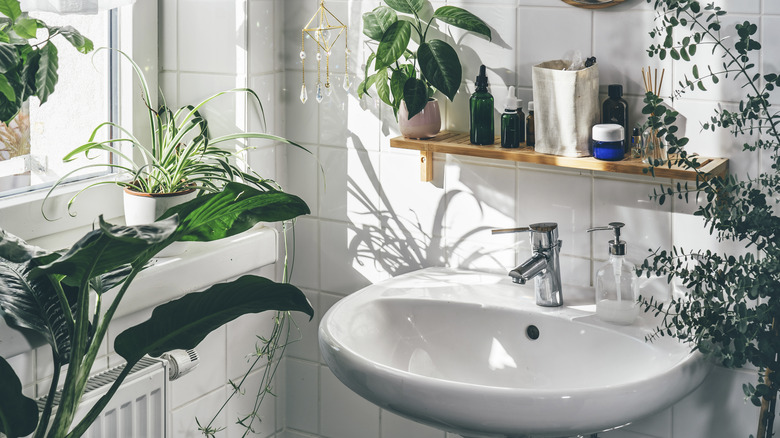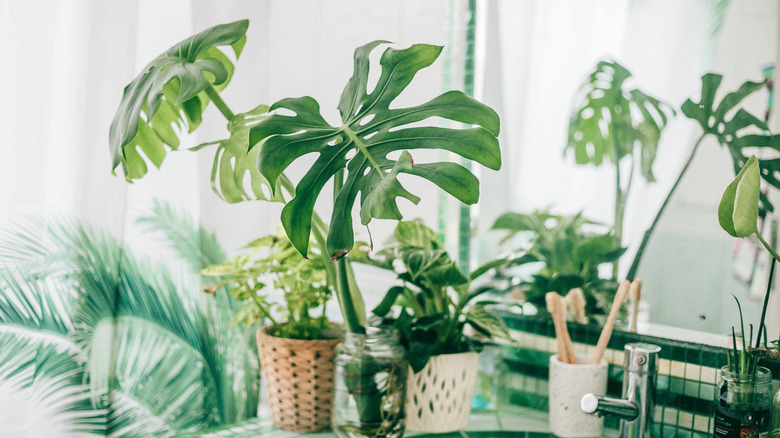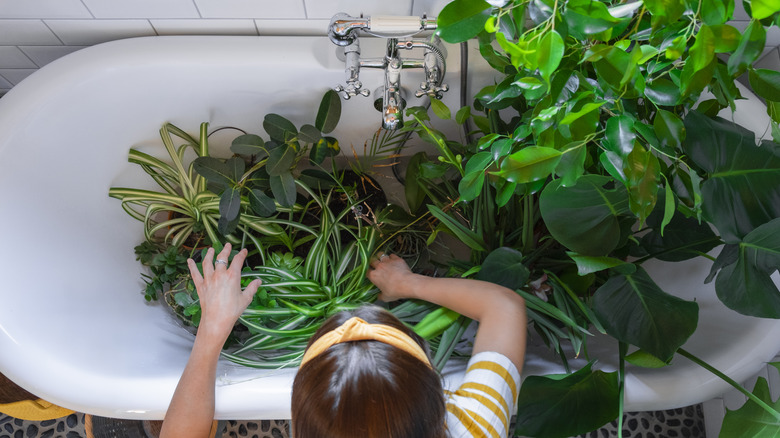Tips For Growing Healthy Houseplants In Your Bathroom
What's the difference between a boring bathroom and a spa-like sanctum? Plants. Add enough plants, and you can turn pretty much any bathroom into a restorative and peaceful environment. That goes for the rest of your home, too, but turning your bathroom into a tropical oasis is especially simple because those environments and bathrooms have one key thing in common: humidity. To grow healthy houseplants in your bathroom, be sure that they get enough moisture and light, maintain a careful watering schedule, and clean them occasionally.
Bathrooms are typically the most humid room in the home thanks to all those showers, making them a great spot for moisture-loving houseplants. Many common houseplants fall into this category — for example, monsteras, philodendrons, and orchids are all native to humid climates. Tropical and subtropical plants are popular for growing indoors because they thrive in year-round warm temperatures and shade, similar to the inside of our houses. They also thrive in humidity, and that's one area where our indoor environments can fall a bit short, at least when compared to a jungle. But bathrooms are a nice step up.
Not all houseplants grow well in bathrooms, and not all bathrooms are suitable for growing plants without some modifications. But overall, growing healthy plants in a bathroom can be easy under the right conditions. Here's how to make it work.
Picking the right bathroom plants
The best indoor plants to keep in your bathroom are those that grow well in high humidity. You have tons of popular houseplants to choose from, including spider plants, ZZ plants, ferns, peace lilies, orchids, ivy, and many more. The only plants you definitely want to avoid are those that are native to dry, desert climates, which are also common houseplants — think cacti and succulents. These types of plants need minimal moisture and shade.
It's also important to consider how much light your bathroom can provide. It's best if it has windows or skylights; even shade-loving plants need to get some natural light. Growing plants in a windowless bathroom is more challenging — some people move the plants to a light source regularly to keep them alive, but constant movement may not be best for the plants. You can invest in grow lights, switch to fluorescent lights, or consider using fake plants instead.
Tips on watering and cleaning
Bathroom plants can be relatively low maintenance, but they still need proper care to stay healthy. The minimum level of humidity for most houseplants to thrive is 50%. You can check the humidity in your bathroom with a hygrometer, which you might need if you don't already have one. If your bathroom is not humid enough, you can help your plants out by placing the pot on a tray of water and pebbles, hanging them closer to the shower (or even inside it), and grouping plants close together.
High humidity can help houseplants stay hydrated for longer, but they still need regular watering. The exact schedule depends on the plant; some like consistently moist soil and some need to dry out between waterings. Remember to check the soil moisture level regularly and water as needed.
Lastly, bathroom plants may get dust and soap residue on their leaves over time. An occasional shower can help clean them off, which could clear off any visible pests. Some plants prefer not to get their leaves wet, in which case you can simply wipe them off with a damp cloth.


